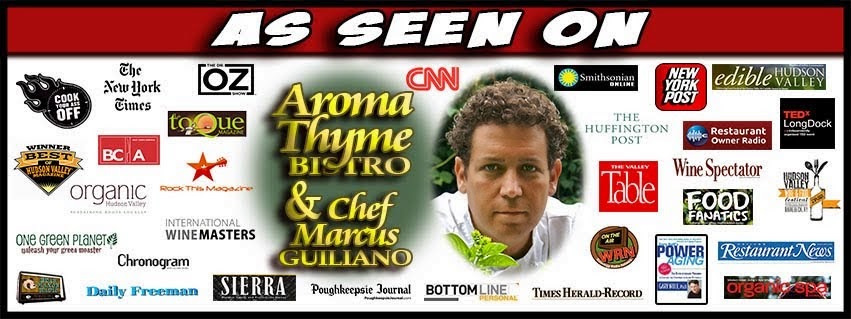Say No To Farmed Salmon.
“My restaurant will never serve Atlantic Salmon” says Chef Marcus Guiliano
of Aroma Thyme Bistro, Ellenville, New York www.aromathymebistro.com
Why?
“It’s farmed salmon, and that’s unhealthy salmon. It’s caged, it’s fed dye and anti-biotics. I will never use it.”
Aroma Thyme Bistro, Chef Marcus’s restaurant in the Catskills, serves only wild Pacific Salmon, primarily Alaskan Salmon.
“It’s a lot of work, just getting the fish, but it’s worth it. We follow the rivers, and we switch back and forth between the top Salmon as the season progresses. That means King Salmon whenever possible, and Coho and Sockeye now and then.”
The best areas?
“Yukon River. When a fish has to swim 2,300 miles to spawn that’s a mighty fish. Before they set off up the river those salmon build themselves up. They feed on krill and small fish until they’re in tip-top condition, and then they charge up that river. We also look for Taku, Stikine, Copper and other river run fish as well as ocean caught from Kenai, Kodiak, Sitka and Cooks Inlet.”
The result?
“That’s the best tasting salmon there is. There’s no comparison with the farmed stuff. The texture is incredible, the flavor is fantastic.”
How does he get it?
“Wild Alaskan Salmon runs from spring to the fall, river by river. As a buyer, though, you just never know for sure what species is available in any given week. That means you don’t just call up your supplier and order salmon! You really work the phones! You really have to play the market if you’re going to be serious about providing the best quality, by which I mean the healthiest, best tasting salmon for your restaurant. One thing that’s tricky is that you never know the price until you call and it varies widely, based on the area being fished, the quantity available and the method of fishing.”
What’s the best method then?
“Trolling, line fishing basically. It avoids the terrible wastage problem with any commercial netting fishery. But it adds $3 to $5 a pound to the fish. I would rather pay that then contribute to tons of bycatch, other fish that is caught and thrown away by net fishermen.”
And finally, how do you like to cook them?
“When the fat content is relatively low, like with Coho Salmon, I like to cook them with Asian sauces. The lower fat content allows the use of many sauces and interesting flavors. But the high fat content of the big King Salmon should be left alone. That fish is perfect as it is. I love a piece of grilled King Salmon with a little touch of lemon and sea salt, and of course, the char marks from the grill.”

First Green Certified© Restaurant in the Hudson Valley, Ellenville (Ulster County) NY. New American menu with grass-fed steaks, seafood & vegetarian. One of the best stocked bars in the Hudson Valley with 300 craft beers, 300 wines & independent produced spirits. Hudson Valley Magazine “Best Of” winner 10 years in a row. Awards include: Best Beer Menu, Best Chef, Best Bistro, Best Vegetarian, Best of County & Best Wine List. Trip Advisor's Number 1 restaurant.
Pages
- Home
- Guest Reviews
- Yelp Reviews
- Dinner Menu
- Today's Specials
- Brunch Menu
- Dessert Menu
- Weekly Specials
- Happy Hour
- Beer: Bottles & Cans
- Beer on Tap
- Award Winning Wine LIst
- Full Bar lIst
- Bourbon, Whiskey & Scotch
- Why We Won't Serve Farmed Salmon
- Catering
- Calendar of Events
- Chef Marcus Guiliano
- Our Story
- YouTube
- Ellenville Run Like The Wind 5 & 10K Race
- Region
- Health
- Loyalty Program
- Links
- Local Business
- Is Aroma Thyme Expensive
- Contact Us & Hours
Friday, September 21, 2007
Subscribe to:
Posts (Atom)
We would never expect you to eat this shrimp, nor do we serve farmed Asian shrimp

